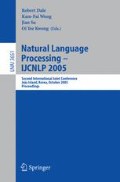Abstract
The paper introduces a method for interpreting novel noun compounds with semantic relations. The method is built around word similarity with pre-tagged noun compounds, based on WordNet::Similarity. Over 1,088 training instances and 1,081 test instances from the Wall Street Journal in the Penn Treebank, the proposed method was able to correctly classify 53.3% of the test noun compounds. We also investigated the relative contribution of the modifier and the head noun in noun compounds of different semantic types.
Access this chapter
Tax calculation will be finalised at checkout
Purchases are for personal use only
Preview
Unable to display preview. Download preview PDF.
References
Cao, Y., Li, H.: Base noun phrase translation using web data and the em algorithm. In: COLING 2002 (2002)
Baldwin, T., Tanaka, T.: Translation by machine of compound nominals: Getting it right. In: ACL 2004-MWE, Barcelona, Spain, pp. 24–31 (2004)
Lauer, M.: Designing Statistical Language Learners: Experiments on Noun Compounds. PhD thesis, Macquarie University (1995)
Lapata, M.: The disambiguation of nominalizations. Comput. Linguist. 28, 357–388 (2002)
Finin, T.W.: The semantic interpretation of compound nominals. PhD thesis, University of Illinois, Urbana, Illinois, USA (1980)
Vanderwende, L.: Algorithm for automatic interpretation of noun sequences. In: Proceedings of the 15th conference on Computational linguistics, pp. 782–788 (1994)
Rosario, B., Marti, H.: Classifying the semantic relations in noun compounds via a domain-specific lexical hierarchy. In: Proceedings of the 2001 Conference on Empirical Methods in Natural Language Processing, pp. 82–90 (2001)
Moldovan, D., Badulescu, A., Tatu, M., Antohe, D., Girju, R.: Models for the semantic classification of noun phrases. In: HLT-NAACL 2004: Workshop on Computational Lexical Semantics, pp. 60–67 (2004)
Fan, J., Barker, K., Porter, B.W.: The knowledge required to interpret noun compounds. In: Seventh International Joint Conference on Artificial Intelligence, pp. 1483–1485 (2003)
Barker, K., Szpakowicz, S.: Semi-automatic recognition of noun modifier relationships. In: Proceedings of the 17th international conference on Computational linguistics, pp. 96–102 (1998)
Artiles, J., Penas, A., Verdejo, F.: Word sense disambiguation based on term to term similarity in a context space. In: Senseval-3: Third International Workshop on the Evaluation of Systems for the Semantic Analysis of Text, pp. 58–63 (2004)
Patwardhan, S., Banerjee, S., Pedersen, T.: Using measures of semantic relatedness for word sense disambiguation. In: Proceedings of the Fourth International Conference on Intelligent Text Processing and Computational Linguistics (2003)
Resnik, P.: Disambiguating noun groupings with respect to wordnet senses. In: Proceedings of the 3rd Workship on Very Large Corpus, pp. 77–98 (1995)
Wu, Z., Palmer, M.: Verb semantics and lexical selection. In: 32nd. Annual Meeting of the Association for Computational Linguistics, pp. 133–138 (1994)
Fellbaum, C. (ed.): WordNet: An Electronic Lexical Database. MIT Press, Cambridge (1998)
Leacock, C., Chodorow, N.: Combining local context and wordnet similarity for word sense identification. In: [15] (1998)
Jiang, J., Conrath, D.: Semantic similarity based on corpus statistics and lexical taxonomy. In: Proceedings on International Conference on Research in Computational Linguistics, pp. 19–33 (1998)
Lin, D.: An information-theoretic definition of similarity. In: Proceedings of the International Conference on Machine Learning (1998)
Banerjee, S., Pedersen, T.: Extended gloss overlaps as a measure of semantic relatedness. In: Proceedings of the Eighteenth International Joint Conference on Artificial Intelligence, pp. 805–810 (2003)
Levi, J.: The syntax and semantics of complex nominals. Academic Press, New York (1979)
Downing, P.: On the creation and use of English compound nouns. Language 53, 810–842 (1977)
Author information
Authors and Affiliations
Editor information
Editors and Affiliations
Rights and permissions
Copyright information
© 2005 Springer-Verlag Berlin Heidelberg
About this paper
Cite this paper
Kim, S.N., Baldwin, T. (2005). Automatic Interpretation of Noun Compounds Using WordNet Similarity. In: Dale, R., Wong, KF., Su, J., Kwong, O.Y. (eds) Natural Language Processing – IJCNLP 2005. IJCNLP 2005. Lecture Notes in Computer Science(), vol 3651. Springer, Berlin, Heidelberg. https://doi.org/10.1007/11562214_82
Download citation
DOI: https://doi.org/10.1007/11562214_82
Publisher Name: Springer, Berlin, Heidelberg
Print ISBN: 978-3-540-29172-5
Online ISBN: 978-3-540-31724-1
eBook Packages: Computer ScienceComputer Science (R0)

